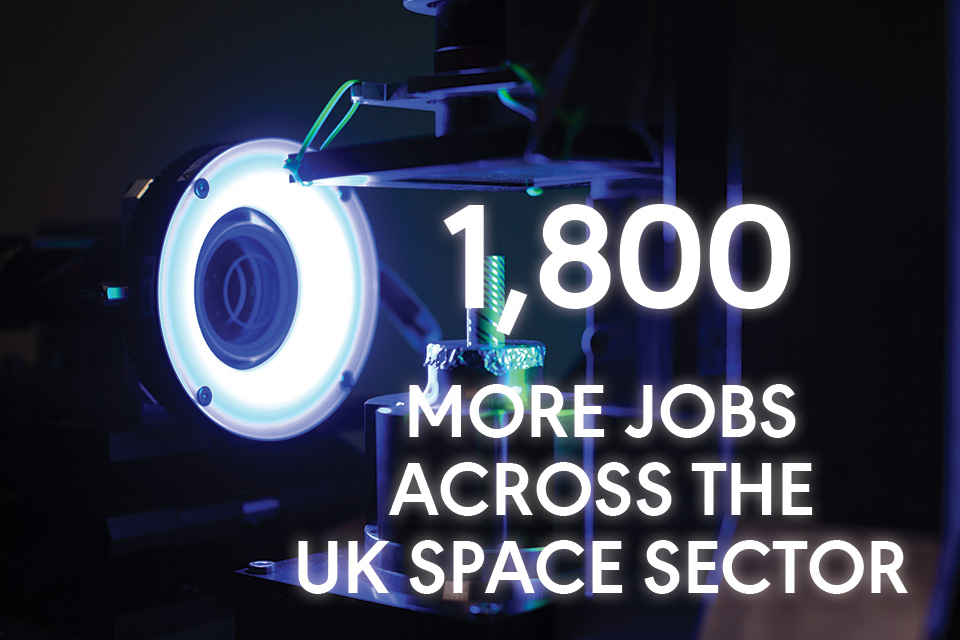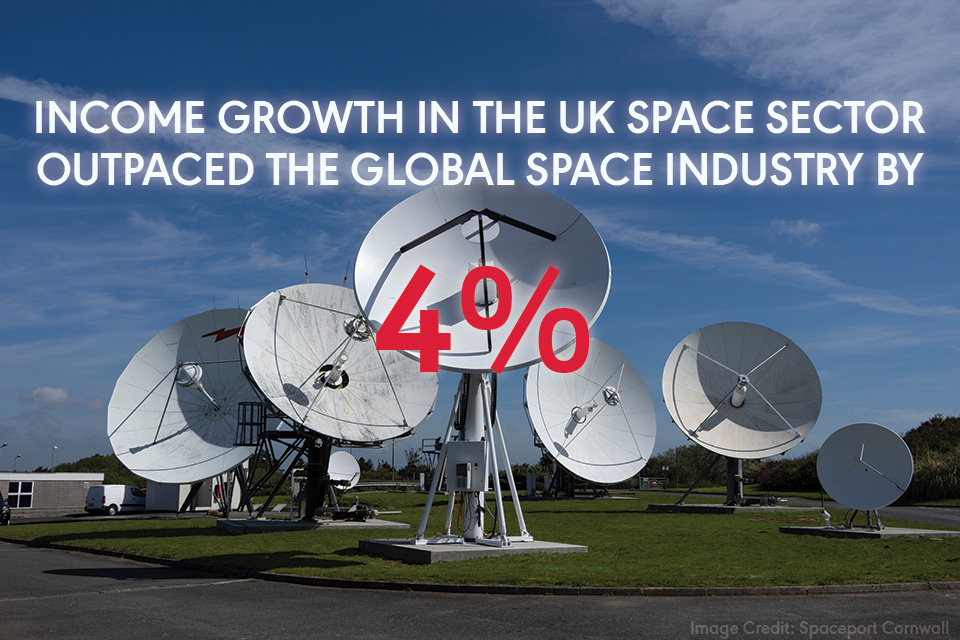- New figures show UK space sector income grew by almost £1 billion into 2021
- Employment up with almost 1,800 more jobs across the UK space sector
- Number of space organisations up by almost 300
- Regions such as West Midlands, North West, North East, and Yorkshire and the Humber, saw significant growth, as well as Northern Ireland and Wales
Despite the global disruption caused by the COVID-19 pandemic, space organisations presented a robust picture, generating £17.5 billion in 2021, compared to £16.5 billion the previous year.
Figures in the latest Size & Health of the UK Space Industry report show the number of space organisations identified across the UK rose from 1,293 to 1,590, creating 1,772 jobs. The sector now employs just under 48,800 people and supports an estimated 126,800 UK jobs across the wider supply chain.
Secretary of State for Science, Innovation and Technology, Michelle Donelan, said:
With the global space economy expanding rapidly, investing in UK our space capabilities can unlock new opportunities, bringing more jobs, skills and businesses to the UK.
The government is committed to supporting this high-growth sector, boosting the UK's reputation as a growing space power, and inspiring the next generation of professionals.

The West Midlands, East of England and Wales saw the highest proportional growth in space sector income, while Northern Ireland, Yorkshire and the Humber and the North East of England experienced the biggest proportional increase in number of space organisations. Employment rose by the largest proportion in the North West and East of England.
Dr Paul Bate, Chief Executive at the UK Space Agency, said:
The £1 billion increase in sector income and £635 million investment generated by UK companies shows the confidence of investors and businesses in the UK space sector. The UK Space Agency will continue to catalyse investment to maintain this positive growth and bring further benefits across the UK economy, the science community and to the planet as a whole.
World-class satellite manufacturing, science and technology expertise have ensured the UK plays a key role in major international missions, and we are increasing our national capabilities in fast-growing areas.
We have seen a significant rise of space organisations in Northern Ireland and northern parts of England, of sector income in the East of England, West Midlands and Wales, and of employment in the North West. To ensure we continue this journey, it's crucial that we nurture skills and expertise, both established and emerging, all over the UK.
Space applications generally, which incorporate services such as broadcasting and mobile satellite communications, space manufacturing, including satellites and scientific instruments for space missions, and space operations and ancillary services were the biggest growth drivers.
John Hanley, Chair of the UKspace trade body, said:
Further growth in the UK space sector, particularly during what was an incredibly challenging time for most UK industries, demonstrates the sector's resilience and ingenuity. It is gratifying to see the sector growing in areas of the country that have previously been under represented - we look forward to supporting these new entrants to the space sector through our new cluster membership of UKspace.
These positive figures underline the opportunities that space offers to drive inspiration, aspiration and productive jobs across the UK. In order to capitalise on this, we must further strengthen our partnerships to maintain growth across the whole of the sector, allowing us to extend our reach and support the UK space industry in cementing its position as a leading player in the global space arena.

Confidence withstands more challenges
The 5.1% growth in income shows a higher growth rate than recent years and outpaced both the growth of the global space industry in the same period (1.6%) and the general UK economy, which contracted by 7.6%.
Despite the challenges of the cost of living, survey respondents were optimistic about the future, with 3 in 5 expecting to grow their income over the next few years, over half (58%) expecting to employ more staff, and half anticipating higher investments.
Nearly three quarters of survey respondents cited support from the UK Space Agency as a key enabler for commercial success.
Who is investing?
Space continues to attract a diverse range of investors, mostly (89%) from the private sector. Figures for 2022 (using Crunchbase) show that an estimated £635 million was invested in UK-headquartered space companies through 34 identified deals, with acquisitions accounting for three quarters of the total investment value. There has been a steady upward trend in both the number of investments (from one in 2012 to 34 last year) and population of investors (from one in 2012 to 66 last year).
Par Equity, Innovate UK and the Scottish Investment Bank have been the source of most deals during this time.
Case study: Goonhilly Earth Station
Goonhilly Earth Station in Cornwall is growing its deep space communications and last year supported NASA's Artemis 1 lunar mission, providing telecommand for six of the cubesats on board.
As well as its ongoing work with the European Space Agency, Goonhilly has been supporting iSpace Kahuto-R - the first privately launched lunar lander - the Indian Space Agency's Chandrayaan 3 and Aditya L1 missions, and it recently acquired COMSAT teleports in the US.
The team is also developing tracking antenna technology for space launches, which was successfully used for Virgin Orbit's launch from Spaceport Cornwall in January, a giant super-cooled antenna to analyse space-based objects, and a range of simulator equipment.
Ian Jones, Chief Executive at Goonhilly Earth Station, said:
The space sector forms a vital part of modern infrastructure, which we take for granted without giving it a second thought. In a similar way that we expect clean water and electricity to be seamlessly delivered, data from satellites form a key element in enabling and monitoring complex services and systems. It provides scientific knowledge as well as helping us to communicate, navigate, travel, maintain security, monitor the weather and climate, and so much more.
However, none of the advantages enabled by satellites and spacecraft can be achieved without specialist ground communication services which monitor, command and interact with them. This is the role that Goonhilly provides.
Data source
Data have been compared between last year's report and this publication. While efforts have been made to maintain the methodology to support comparability, there were some methodological improvements, which are detailed in this year's report. As with any piece of research there are limitations and caveats to the data. These are clearly explained in this year's report.






